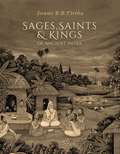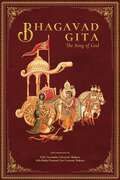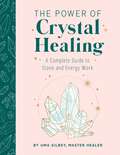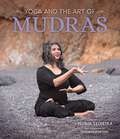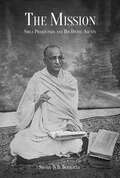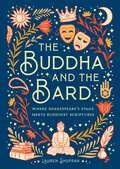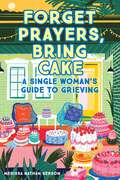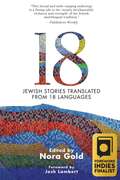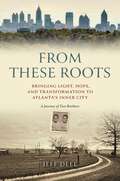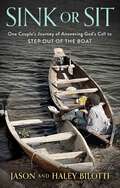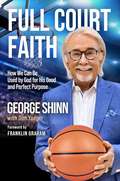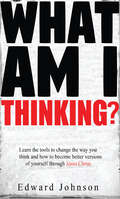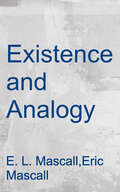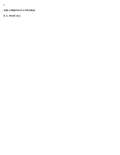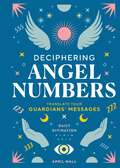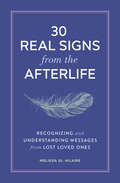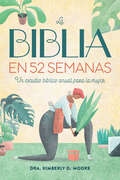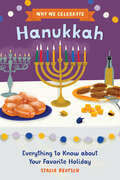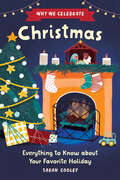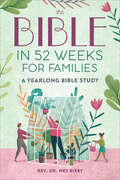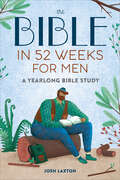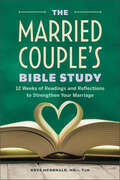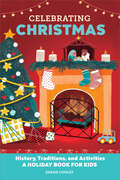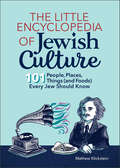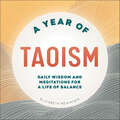- Table View
- List View
Sages, Saints & Kings of Ancient India
by Swami B. B. Tirtha MaharajaThe people of ancient times were inclined to give their attention not only to the external world of inert matter, but also to the world within, the vital world of consciousness. Those sages who understood the importance of such contemplation comprise the prime subject matter of this book. Especially in the troubled world of today, it is by the conscientious study of their activities and teachings that we may come to understand the Absolute Truth, or the Ultimate Reality, and attain lasting peace and joy. The pastimes of such great, sagely personalities have been narrated in detail in an ancient collection of works known as the Puranas, as well as in timeless epics such as the Mahabharata, Ramayana, and other Vedic literatures. In this book, Srila Bhakti Ballabha Tirtha Goswami Maharaja, a bona fide self-realized representative of the bhakti (devotional) lineage, has narrated important episodes and addressed salient points from these literatures. Thus, the avid reader may understand their inner meaning and apply this knowledge to their search for real happiness. Ultimately, such unadulterated, permanent happiness, according to the devotional tradition, is realized as the attainment of pure love of God, Sri Krishna.
Bhagavad Gita: The Song of God
by Swami B. Puri&“One who sings and chants these supremely confidential teachings to My devotees will attain supreme devotion for Me and will attain Me. There is no doubt in this matter.&” —Sri Krishna, Bhagavad-gita 18.68If sharing the confidential meaning of the yoga of devotional love, bhakti-yoga, is the standard for spiritual advancement, then this is the definitive edition of the Bhagavad-gita. It is the first English translation that includes summaries of the commentaries of four of the most prominent expounders of the tradition of bhakti-yoga: Srimad Bhaktivinoda ?hakura, Srimad Visvanatha Cakravarti Thakura, Srila Bhakti Pramode Puri Gosvami, and Sri Kanailal Pancatirtha—alongside the highly acclaimed translation of the text itself by Srila Bhakti Rakshak Sridhar Dev Gosvami. Taken together, no other edition of this sacred text has so comprehensively conveyed the timeless spiritual wisdom of the Bhagavad-gita.
The Power of Crystal Healing: A Complete Guide to Stone and Energy Work
by Uma SilbeyThe Power of Crystal Healing will focus primarily on practical application of stones as a source of healing for afflictions ranging from fatigue to high blood pressure. Uma Silbey, applying her 40 years of experience, presents proven crystal and stone techniques that work to heal the body, mind, emotions, and spirit. Step-by-step instructions for both the beginner and the advanced show how to use crystals to help heal a diverse array of physical ailments like the flu and colds, cancers, nerve and blood disorders, migraine headaches, exhaustion, and stress, as well as emotional concerns like anger and depression, shame and guilt, loss, heartbreak, and finding love. The use of crystals to help heal common mental issues, such as anxiety and narcissism, OCD, suicidal ideation, PTSD, abusive behaviors, and self-harm, is also included. Though the use of crystals themselves can lead to a vastly expanded consciousness, the ability to &“feel&” or sense the vibrational fields that form the basis of all manifestation can help develop vast intuitive and psychic abilities and bring a deep sense of self. Specific techniques are given to help accelerate these processes. With easy-to-follow instructions, guidelines for building a personal &“Crystal Healing Kit,&” a diverse array of practices and powerful meditations, and over 100 beautiful pictures of the most powerful healing stones, this book will be an amazing first step for readers seeking a path of transformative healing.
Yoga and the Art of Mudras
by Teixeira NubiaA unique yoga guide that fuses traditional asana with mudra and storytelling from the bhakti yoga traditionYoga and the Art of Mudras is a guided journey into the alchemy of asana (yoga pose) and mudra (symbolic hand gesture). Brazilian-born yogini, dancer, and author Nubia Teixeira has been practicing and teaching traditional yoga and classical Indian Odissi dance for over twenty-six years. In this book, she fuses her passion for yoga and dance with her love for bhakti (devotion). In so doing, she has created a unique and contemporary yoga system that encompasses all three healing arts. Through beautiful photographs of each yoga pose, Nubia guides the reader in a meaningful union of hand gestures with asanas. Drawing, in particular, on expressions and hand gestures found in Indian dance, these newly developed poses will help transform a person&’s hatha yoga practice into an embodied devotional and artistic yogic experience. Nubia&’s yoga-mudra system combines expressions that are deeply rooted in the heart of traditional yoga, classical Indian Odissi dance, and inspirational bhakti yoga storytelling. Honoring the gifts of all three systems, Nubia Teixeira shares a didactic, beautiful, and truly original voyage into the heart of devotional yoga practice.
The Mission: Srila Prabhupada and His Divine Agents
by Swami B.B. BodhayenThe lives of Srila Prabhupada and his disciples are recounted, encouraging all to follow the devotional path of Bhakti, and be liberated in the eternally blissful spiritual realm.The Mission: Srila Prabhupada and His Divine Agents illustrates the life and teachings of a spiritual visionary, highlighting his enduring and inspiring legacy. The son and successor of the great Gaudiya Vaishnava acharya Srila Bhaktivinode Thakur, Srila Prabhupada established the Gaudiya Math, a dynamic spiritual and educational mission with 64 branches in India and several international centers, which have spread the teachings of Chaitanya Mahaprabhu around the world. His noble life&’s mission, powerful speeches and writings, and devoted disciples and followers continue his legacy of wisdom and divine love. Chaitanya Mahaprabhu&’s philosophy is centered on the ideal that we should be soul conscious, rather than body conscious. The Mission: Srila Prabhupada and His Divine Agents explores and explains how to use this philosophy to deliver oneself from attachments to material existence and achieve the ultimate goal: chanting the Mahamantra with pure devotion.
The Buddha and the Bard
by Lauren ShufranWhat does Shakespeare have to teach us about mindfulness? What Eastern spiritual views about death, love, and presence are reflected in the writings of The Bard? The Buddha and the Bard reveals the surprising connections between the 2,500-year-old spiritual leader and the most compelling writer of all time. &“Shufran&’s compelling juxtapositions will encourage the reader to ask the deepest questions of themselves while delighting in the play of resonances across a cultural and historical divide.&” – YOGA Magazine Shakespeare understood and represented the human condition better than any writer of his time. As for the Buddha, he saw how to liberate us from that condition. Author Lauren Shufran explores the fascinating interplay of Western drama and Eastern philosophy by pairing quotes from Shakespeare with the tenets of an Eastern spiritual practice, sparking a compelling dialogue between the two. There&’s a remarkable interchange of echoes between Shakespeare&’s conception of &“the inward man&” and Buddhist approaches to recognizing, honoring, and working with our humanness as we play out our roles on the &“stage&” of our lives. The Buddha and the Bard synthesizes literature and scripture, embodied drama and transcendent practice, to shape a multifaceted lyric that we can apply as mindful practice in our own lives. Shufran&’s compelling juxtapositions will encourage the reader to ask the deepest questions of themselves while delighting in the play of resonances across a cultural and historical divide.
Forget Prayers, Bring Cake: A Single Woman's Guide to Grieving
by Merissa Nathan GersonThough at times it may seem impossible, we can heal with help from our friends and community– if we know how to ask. This heartrending, relatable account of one woman&’s reckoning with loss is a guide to the world of self-recovery, self-love, and the skills necessary to meeting one's own needs in these times of pain– especially when that pain is suffered alone. Grief is all around us. In the world of today it has become common and layered, no longer only an occasional weight. A book needed now more than ever, Forget Prayers, Bring Cake is for people of all ages and orientations dealing with grief of any sort—professional, personal, romantic, familial, or even the sadness of the modern day. This book provides actions to boost self-care and self-worth; it shows when and how to ask for love and attention, and how to provide it for others. It shows that it is okay to define your needs and ask others to share theirs. In a moment in which community, affection, and generosity are needed more than ever, this book is an indispensable road map. This book will be a guiding light to a healthier mental state amid these troubled times.
18: Jewish Stories Translated From 18 Languages
by Nora GoldA 2023 Foreword INDIES Book of the Year Finalist in the Anthologies Category This anthology, the first of this kind in twenty-five years, collects eighteen astounding works of Jewish fiction. This is the first anthology of translated multilingual Jewish fiction in 25 years: a collection of 18 splendid stories, each translated into English from a different language: Albanian, Croatian, Czech, Danish, French, German, Greek, Hebrew, Hungarian, Italian, Ladino, Polish, Portuguese, Romanian, Russian, Spanish, Turkish, and Yiddish. These compelling, humorous, and moving stories, written by eminent authors that include Shmuel Yosef Agnon, Isaac Babel, and Lili Berger, reflect both the diversities and the commonalities within Jewish culture, and will make you laugh, cry, and think. This beautiful book is easily accessible and enjoyable not only for Jewish readers, but for story-lovers of all backgrounds. Authors (in the order they appear in the book) include: Elie Wiesel, Varda Fiszbein, S. Y. Agnon, Gábor T. Szántó, Jasminka Domaš, Augusto Segre, Lili Berger, Peter Sichrovsky, Maciej Płaza, Entela Kasi, Norman Manea, Luize Valente, Eliya Karmona, Birte Kont, Michel Fais, Irena Dousková, Mario Levi, and Isaac Babel.
From These Roots: Bringing Light, Hope, and Transformation to Atlanta's Inner City—A Journey of Two Brothers
by Jeff DeelPart memoir, part inspirational, Jeff Deel&’s From These Roots tells of his sometimes michievous childhood as the son of a holiness preacher and the change of heart and events that led him as an adult to work alongside his brother, ministering to the lost and forgotten people of Atlanta&’s inner city.Through Jeff&’s stories from his own past, along with those of the countless transformations he has witnessed at City of Refuge, readers will see how being a follower can be just as important as being a leader. Jeff Deel has lived in the shadow of his older brother, Bruce, for his entire life. He wouldn&’t have had it any other way. While being the sons of a holiness preacher, they still found ways to get into their fair share of mischief, with older brother Bruce taking on the role of &“leader&”—for better or worse. Yet Jeff never questioned his place as his brother&’s follower and supporter—for better or worse. Then came adulthood and Jeff&’s turbulent search to find himself. Through a series of failed occupations and the desire to avoid ministry at all costs, Jeff was predictably led right back to his brother&’s side. This time, instead of finding mischief, Jeff and Bruce worked together building the City of Refuge in Atlanta. Through their work, COR has welcomed thousands upon thousands of individuals who have found themselves in dire straits, whether as victims of abuse and sex trafficking, or as people whose own choices have thrust them to rock bottom. Jeff and Bruce have found their experience watching their parents minister to the least of these and teaching them what it means to offer a person dignity, love, and hope, prepared them more than they ever could have realized.
Sink or Sit: One Couple's Journey of Answering God's Call to Step Out of the Boat
by Jason Bilotti Haley BilottiJason and Haley Bilotti&’s Sink or Sit will inspire and challenge readers to get out of their comfort zones and step into God&’s call, to stop sitting in place but to be willing to take risks, even if that means sinking while doing it.It&’s probably happened to you. You felt that nudge, an urge, from deep inside you, calling you out of your comfort zone. Calling to you to take a risk. You have felt that call from God, asking you to step out of the boat, to do something significant. Jason and Haley Bilotti each felt it—for years. But as they began to have children and their obligations with Chick-fil-A grew, they didn&’t see a way to answer the call of their hearts: to serve God through missions. When the opportunity presented itself for them to take separate missions trips, they learned just how creative God truly is. They began leading separate teams to Niger, in western Africa, and to serve the neediest of all, the children. Through their work with Schools for Niger, Africa, an organization the Bilottis and their business associates started, they found inroads to countless communities throughout Niger. Their work also led them to meet their future son, Rachid, a child they first sponsored and later adopted. Jason and Haley tell their touching story using alternating perspectives, while also bringing in their grown children to help tell it from their own points of view. In reading this book, you will sense their passion for serving the lost and forgotten, and you will feel the love they have for the people God has brought their way. The Bilottis&’ story, Sink or Sit, will both inspire and empower you to take your own leap. To get out of that boat. To trust that sinking is better than sitting.
Full Court Faith: How We Can Be Used by God for His Good and Perfect Purpose
by George ShinnIn Full Court Faith, George Shinn's remarkable journey from small-town obscurity to NBA franchise owner shows how trusting God's plan can lead to incredible success, redemption, and miraculous life transformations."&“God has done many wonderful things in my life—but the biggest things aren&’t the accomplishments I used to take the most pride in.&” —George Shinn What can God do with a poor country boy from a small town in North Carolina? The child no one expected much from. The kid who finished high school dead last in his graduating class. One of only two students in the whole school on government assistance. The young man who had to clean business school toilets in exchange for tuition. The aspiring pro-sports franchise owner no one in New York or California took seriously. The victim of an extortion scandal that rocked the sports and business communities of Charlotte, North Carolina. The sinner whose private mistakes became front-page news for more than a year. What can God do with a person like that? Amazing things . . . things that lead to unbelievable fame and fortune. Wonderful things . . . things that brought new life and vigor to a southern gem no one outside the south had ever heard of. Miraculous things . . . things that have saved the lives of numerous stroke victims—including his own. Full Court Faith presents the uniquely inspiring life of Charlotte entrepreneur, businessman, and former NBA franchisee George Shinn, the man who brought professional sports to North Carolina. With charm, wit, humility, and his trademark enthusiasm, Shinn tells his story his way—taking responsibility for the mistakes and giving God all the credit for the victories. If you&’ve ever wondered, What could God do with someone like me? Full Court Faith brings you the answer: Anything He wants. As long as you&’re willing to trust Him on the journey.
What AM I Thinking?
by Edward JohnsonLearn the tools to change the way you think and how to become better versions of yourself through Jesus Christ.
Existence and Analogy: A Sequel to He Who Is
by E. L. Mascall Eric MascallThis book takes the doctrine of analogy and the equally important doctrine of existence as guiding principles for a survey of the foundations of natural theology. Both doctrines are treated in depth here, and readers of the same author’s He Who Is: A Study in Traditional Theism — where frequent reference is made to the doctrine of analogy — will find the present work not only a significant elaboration of the outline sketched there, but also an original and suggestive presentation of such a doctrine.
The Christian Universe
by E. L. Mascall Eric MascallThe Christian Universe is an unabashed defense of Christianity against the unbelief and indifference of our age: all who would deny human freedom and responsibility; all who would maintain that life and existence are meaningless; and all who (under whatever banner) would persuade us that the secular is all in all, or that nothing beyond our own immediate empirical world can be known. Under Mascall’s lens, those who hold such positions are seen as offering a dreary and impoverished universe, “quite incapable of satisfying our needs and aspirations.” In contrast, he upholds “the wonder and glory of Christianity,” its unique revelation and reconciliation with God as the heart of the cosmic process, and its faith not a defiance or negation of the world, but an affirmation that there is meaning to the world.
Deciphering Angel Numbers: Translate Your Guardians' Messages
by April WallDiscover the mystical meaning of angel numbers and the connection they have to your higher self. Follow along and find all of your answers in Deciphering Angel Numbers.As the third book in Weldon Owen&’s Daily Divination series, Deciphering Angel Numbers dives into numerology to define the concept of angel numbers and explores the unique history of the mystical practice. Angel numbers are a large part of modern metaphysical practices, and these trios of numbers are a wonderful tool in managing life challenges, recognizing messages from spirit guides, and staying connected to those who have passed on. Join author April Wall as she provides a complete history of angel numbers, including a full glossary on all the numbers, who sends them, explanations on how to interpret them accurately, and all the answers you need in learning how to incorporate their spiritual meanings into your daily life. ALL OF YOUR ANGEL NUMBER QUESTIONS ANSWERED: The only angel number guidebook you will ever need! With thorough explanations, tips on finding the patterns, and a history of numerology, this guide is the total package. COMPLETE YOUR COLLECTION: Collect the entire Daily Divination series to increase your divination skill set. EXPERT GUIDANCE: Author April Wall has worked in the metaphysical space for over ten years. She is an authentic and reliable source in learning to communicate with your higher self and those beyond. PERFECT GIFT: This book makes the perfect gift for any mind, body, and spirit enthusiast in your life.
30 Real Signs from the Afterlife: Recognizing and Understanding Messages from Lost Loved Ones
by Melissa St. HilaireDiscover signals from the spirit world and connect with those you've lostSigns of the spirit world are all around us— which means contacting loved ones and pets who have passed on is possible. This guide shows you how to communicate with the afterlife by noticing and decoding the signs and messages it sends. Author Melissa St. Hilaire explains the essential steps to sensing and understanding spirit energy, setting good intentions before contacting spirits, making a connection, and maintaining that connection for as long as you want.Know the signs — Be ready when the spirits reach out by exploring 30 different ways they make contact, including paranormal activity, a sudden animal appearance, or targeting your senses.Commune and connect — Learn how to keep communication open with meditation, séances, mementos, and more. Then, learn to strengthen those connections through conduits like candles or crystal balls.The meaning in the message — From phantom flavors to psychic visions and temperature changes, learn how to interpret each sign and understand the guidance it is offering you.Record what you receive — Keep track of your messages from your loved ones with fill-in pages that offer space to describe the details of every sign you encounter and what it meant to you.Open yourself up to the spirits that surround you with help from the 30 Real Signs From the Afterlife.
La Biblia en 52 semanas: Un estudio bíblico anual para la mujer (Bible in 52 Weeks)
by Dr. Kimberly D. MooreUn viaje de un año a través de la Biblia para fortalecer la fe de las mujeres.La Biblia siempre te ofrecerá una guía cuando tengas que enfrentar los desafíos de la vida o necesites levantar el ánimo. Este inspirador estudio bíblico para mujeres combina un plan diario de lecturas con acciones semanales para reflexionar, debatir y explorar cómo aplicar la sabiduría de Dios a tu vida diaria.Trasciende otras lecturas cristianas para mujeres con:Lecturas temáticas: cada versículo de la semana presenta temas y tópicos relacionados con la mujer moderna, como la perseverancia ante los desafíos o la superación de los errores, entre otros.Tu traducción favorita de la Biblia: incluye planes de lectura que te permiten trabajar con tu versión favorita de la Biblia para que logres una conexión más profunda con Dios.Diferentes maneras de estudiar: puedes explorar las preguntas interactivas, las sugerencias para llevar un diario bíblico y las oraciones por tu cuenta o de manera grupal.La versión en español de un libro muy querido: la edición traducida del best seller, La Biblia en 52 semanas: Un estudio bíblico anual para la mujer, ¡ahora disponible en español!Conoce la Palabra desde una nueva perspectiva y fortalece tu relación con Cristo a través de este estudio bíblico para mujeres.A yearlong journey through the Bible to strengthen women's faith—the Spanish language version.When you need to lift your spirits or tackle life's challenges, the Bible is always there to offer guidance. This inspiring Bible study for women combines a daily reading plan with weekly opportunities to reflect, discuss, and explore how God's wisdom can be applied to your daily life. Translated from the original version, this edition is available in Spanish!Themed readings—Every verse for the week features themes and topics that are relatable to modern women, like persevering through challenges, moving on from mistakes, and more.Your favorite Bible translation—The included reading plans work with any translation, allowing you to use your favorite Bible to connect with God more deeply.Different ways to study—You can explore the interactive questions, Bible journaling prompts, and prayers on your own or in a group setting.Spanish language version of a beloved book—This is a translated edition of the bestselling The Bible in 52 Weeks: A Yearlong Bible Study for Women, now available in Spanish!Get to know the Word in a new light and strengthen your relationship with Christ in this Spanish Bible study for women.
Why We Celebrate Hanukkah: Everything to Know about Your Favorite Holiday (Why We Celebrate)
by Stacia DeutschCelebrate Hanukkah with this festive introduction for kids ages 6 to 9!Hanukkah is a Jewish holiday that is also called the Festival of Lights. For thousands of years, Jewish people have celebrated Hanukkah by lighting candles, chanting prayers, and playing games! Learn all about the history, traditions, food, and more with this book of facts and activities that encourage you to join in on the fun.So many ways to get festive—Discover how Hanukkah is celebrated by different people around the world with songs, gifts, and gatherings.Celebrate at home—Kids will explore Hanukkah customs with included activities like making your own stained-glass menorah decoration and learning how to play dreidel.Fascinating facts and pictures—Vibrant illustrations and kid-friendly language help bring Hanukkah to life.Discover Why We Celebrate Hanukkah!Have you ever wondered why we exchange gifts on Valentine's Day? Or why we wear green on St. Patrick's Day? Get the rest of the Why We Celebrate series and learn about holidays from around the world!
Why We Celebrate Christmas: Everything to Know about Your Favorite Holiday (Why We Celebrate)
by Sarah CooleyCelebrate Christmas with this festive introduction for kids ages 6 to 9!Christmas is a magical time of year for people all over the world. They decorate their homes, sing songs, give gifts, and spend time together! Learn all about the history, traditions, food, and more with this book of facts and activities that encourage you to join in on the fun.So many ways to get festive—Discover how Christmas is celebrated by different people around the world with parties, music, decorations, and presents.Celebrate at home—Kids will explore Christmas customs with included activities like making Reindeer Cookies, crafting Christmas trees out of yarn, and playing a stocking stuffer guessing game.Fascinating facts and pictures—Vibrant illustrations and kid-friendly language help bring Christmas to life.Discover Why We Celebrate Christmas!Have you ever wondered why we exchange gifts on Valentine's Day? Or why we wear green on St. Patrick's Day? Get the rest of the Why We Celebrate series and learn about holidays from around the world!
The Bible in 52 Weeks for Families: A Yearlong Bible Study (Bible in 52 Weeks)
by Rev. Dr. Wes BixbyAn interactive, yearlong journey through the entire Bible for families—Part of the USA Today bestselling series with the original The Bible in 52 Weeks!Make Bible study even more meaningful by getting the whole family involved! This Bible study guide features a weekly reading plan to lead your family through the entire Bible, a few verses at a time. With weekly insights, discussion questions, and activities, it will spark deeper conversations about faith and inspire every family member to use God's teachings in their own life.All you need is your Bible—Dive into a new entry each week that includes six daily readings from your Bible (and a day to rest), a brief lesson on the theme for the week, a few questions to talk through, and a fun activity to try.One year of reflection—Touch on every chapter of the Bible over the course of a year with a simple schedule that only requires about fifteen minutes of reading each day and one study session each week.Made for families— These lessons are appropriate for all ages so adults, teens, and even young children can learn and grow in their faith.Study with the bestselling series—Find more ways to connect to His word with The Bible in 52 Weeks for Men and the mega-popular, USA Today bestselling The Bible in 52 Weeks for women.Bring your family closer together and closer to God with this yearlong Bible study!
The Bible in 52 Weeks for Men: A Yearlong Bible Study (Bible in 52 Weeks)
by Josh LaxtonAn interactive, yearlong journey through the entire Bible for men—Part of the USA Today bestselling series with the original The Bible in 52 Weeks!Applying the wisdom of the Bible to your life is an integral part of being a Christian man, but it's not always easy to find the time for Bible study. The Bible in 52 Weeks for Men gives you a clear path to connect with the Lord, guiding you as you read the Bible every day for one year. It's an easy reading plan that takes you through Scripture week by week, with included lessons and questions designed to help you strengthen your faith and live by His word.A full year of readings—Learn from every chapter of the Bible with a weekly format that only requires about fifteen minutes of reading each day and only one study session each week.Practical prompts—Contemplate God's teachings with journal entries and exercises that reflect on topics like relationships, family, work, and health.Space for group discussion—Build your fellowship with other Christian men and use this book to hold group study sessions so you can share God's wisdom with friends and family.Study with the bestselling series—Give the gift of deeper faith to everyone in your life with the companion books: The Bible in 52 Weeks for Families, and the mega-popular, USA Today bestseller The Bible in 52 Weeks for women.Get ready to get closer to God with exercises and reading guides that walk you through each part of the Scripture, one day at a time.
The Married Couple's Bible Study: 12 Weeks of Readings and Reflections to Strengthen Your Marriage
by Krys McDonaldStrengthen your marriage through ScriptureAll marriages take effort and intention—and studying Scripture together can provide the guidance you need to thrive at every stage of your relationship. Whether you're going through a challenging time or just looking to grow even closer, this inspiring Bible study shows you how to make your relationship and your faith a priority. Over the course of twelve weeks, you'll deepen your bond with each other while ensuring that God remains at the center of your marriage. Created for busy couples—Carving out time for the Lord is easy; weekly studies consist of three scripture passages, reflective prompts, and prayers you can do together in 15 to 20 minutes. Explore common challenges—Find deeper meaning in God's Word with thoughtful commentary that speaks to issues all married couples face, from establishing good communication to remaining faithful.Lessons for life—Apply the Lord's teaching to your everyday life through engaging activities that ask you to celebrate each other, practice active listening, foster intimacy, and more. Grow closer to your spouse and to the Lord with The MarriedCouple's Bible Study .
Celebrating Christmas: History, Traditions, and Activities – A Holiday Book for Kids (Holiday Books for Kids)
by Sarah CooleyGet into the holiday spirit with this fun Christmas book for kids ages 6 to 9!Christmas is an enchanting time of year for many people around the world. Sparkling lights decorate homes, wrapped gifts are placed under Christmas trees, and carols fill the air. This engaging non-fiction book explains the history and customs of the Christmas holiday and includes entertaining activities that encourage kids to get festive.Many ways to celebrate—From hanging stockings and baking cookies to giving gifts and going to church, kids will learn about all kinds of Christmas traditions.Hands-on holiday activities—Try festivities like making reindeer cookies, creating snowman slime, and crafting a graham cracker gingerbread house!Colorful and illustrated—Bring this beloved holiday to life with vibrant illustrations, fascinating facts, and Christmas greetings in other languages.Celebrate, explore, and learn with this charming choice in holiday books for kids.
The Little Encyclopedia of Jewish Culture: 101 People, Places, Things (and Foods) Every Jew Should Know
by Mathew KlicksteinCelebrate Jewish culture with this fun collection of facts and stories!Jewish traditions aren't just something they sing about in Fiddler on the Roof. Explore them all with this delightful book of essential Jewish foods, philosophers, pop culture, and more. It's sure to be way more satisfying than the typical encyclopedia—but probably not as exciting as finding the perfect bagel. Discover cultural touchstones—From babka to Mel Brooks, learn fascinating facts about the writers, entertainers, delis, and Yiddish phrases that shine a light on Jewish culture through the ages.Find what fascinates you—Paging through this book is a pleasure, whether you choose to read it cover to cover or use it as a quick reference guide. Give the perfect present—This encyclopedia's lighthearted tone and charming illustrations make it a great gift for Chanukah, housewarmings, and more. Show a little chutzpah and pick up a copy of this amusing and informative Jewish encyclopedia today!
A Year of Taoism: Daily Wisdom and Meditations for a Life of Balance (A Year of Daily Reflections)
by Elizabeth ReningerInfuse the Tao 's teachings into your life through 365 days of reflection Taoism is an ancient spiritual tradition that celebrates the natural world and invites you to live in greater harmony with the flow of the universe. Tap into the wisdom of the Tao Te Ching with this book of daily meditation s and practices that cultivate peace, joy, and freedom. 12 months of Taoism —Sharpen your understanding of the Tao's teachings with focused guidance for every month of the year, each highlighting different elements of Taoism like humility and compassion. Brief and meaningful exercises —These inspiring affirmations, insights, and activities only take 10 to 15 minutes, making it easy to incorporate the Tao into your everyday life. An approachable entry point —Even if this is your first foray into Taoism, you'll find practical explanations and simple reflections that encourage you to keep learning. Unlock greater well-being as you embrace the essence of the Tao with A Year of Taoism.
